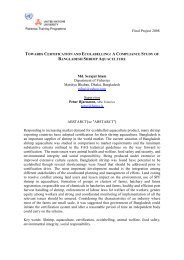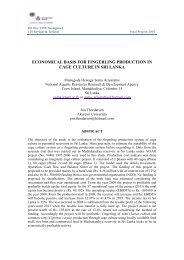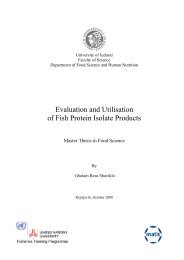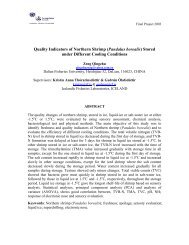Fish species abundance and distribution in The Gambia estuary
Fish species abundance and distribution in The Gambia estuary
Fish species abundance and distribution in The Gambia estuary
Create successful ePaper yourself
Turn your PDF publications into a flip-book with our unique Google optimized e-Paper software.
Darboeat stations <strong>in</strong>dicate the highest <strong>species</strong> richness between stations 19 <strong>and</strong> 26 dur<strong>in</strong>g therelatively high discharge period <strong>in</strong> April at a sal<strong>in</strong>ity range of 10- 22 ppt <strong>and</strong> anaverage of 16.20 ppt. This falls more with<strong>in</strong> the optimum sal<strong>in</strong>ity range <strong>and</strong> averageof typically estuar<strong>in</strong>e <strong>species</strong> than the lower <strong>estuary</strong> between stations 1 <strong>and</strong> 18 wheresal<strong>in</strong>ity dur<strong>in</strong>g the same period ranged between 29 <strong>and</strong> 40 with an average of 29.8 ppt.This could serve as a suitable explanation for the evolution of peaks <strong>in</strong> the lower<strong>estuary</strong>.Total biomass (weight <strong>in</strong> a unit area) <strong>and</strong> fish <strong>abundance</strong> (number of <strong>in</strong>dividuals) <strong>in</strong>the <strong>estuary</strong> show two dist<strong>in</strong>ct identifiable peaks at lower estuar<strong>in</strong>e stations 1-17(Chitabong bolong <strong>and</strong> M<strong>and</strong>ori creek) <strong>and</strong> mid estuar<strong>in</strong>e stations 17-29 (M<strong>and</strong>oriCreek to Wale). <strong>The</strong> former ma<strong>in</strong>ly represent <strong>species</strong> of the family Sciaenidae(Pseudotholithus elongatus etc.), Clupeidae (Ethmalosa fimbriata, Sard<strong>in</strong>ellamaderensis), Pristigastridae (Ilisha africana), <strong>and</strong> Ariidae (Arius heudoloti etc), whichare pure estuar<strong>in</strong>e <strong>species</strong> <strong>and</strong> have a relatively narrow range of sal<strong>in</strong>ity tolerance. <strong>The</strong>latter <strong>in</strong>clude <strong>species</strong> of the family Polynemidae (Polydactylus quadrifilis,Pentanemus qu<strong>in</strong>quarius etc), Mugilidae (Liza gr<strong>and</strong>isquamis, L. falcip<strong>in</strong>nis etc.),Bagridae (Chrysichthys nigrodigitatus, C. Maurus <strong>and</strong> C. Johnelsi), Mochokidae(Synodontis gambiensis, Synodontis batensoda) <strong>and</strong> Schilbeidae (Schilbe<strong>in</strong>termedius).6 CONCLUSIONUnderst<strong>and</strong><strong>in</strong>g the fish community structure <strong>in</strong> the <strong>Gambia</strong> <strong>estuary</strong> could be animportant tool <strong>in</strong> the management of the fisheries of the <strong>estuary</strong>. Despite all thepositive attributes <strong>in</strong> the <strong>estuary</strong> <strong>in</strong> terms of <strong>species</strong> richness, biomass etc., estuar<strong>in</strong>efisheries rema<strong>in</strong> unattractive to many. <strong>The</strong> numerous government calls to people totake up fish<strong>in</strong>g did not yield the much-desired results, at least among <strong>in</strong>digenous<strong>Gambia</strong>ns. It is, therefore, a challeng<strong>in</strong>g task for the Department of <strong>Fish</strong>eries to striveto br<strong>in</strong>g about an attitud<strong>in</strong>al change of people towards fish<strong>in</strong>g. One way to do this, <strong>in</strong>my view, is to make fish<strong>in</strong>g a more profitable venture. An important element <strong>in</strong>achiev<strong>in</strong>g such a goal is to <strong>in</strong>crease Catch Per Unit Effort by an average estuar<strong>in</strong>efisherman through mapp<strong>in</strong>g of <strong>distribution</strong> patterns of commercially important <strong>species</strong>as they relate to time, place <strong>and</strong> environmental factors. <strong>The</strong> <strong>species</strong> occurrence matrix,presented <strong>in</strong> this study could serve as a prototype for such mapp<strong>in</strong>g. Such <strong>in</strong>formationwould be required <strong>in</strong> almost every estuar<strong>in</strong>e-related project <strong>in</strong> the future. <strong>The</strong> projectthat immediately comes to m<strong>in</strong>d here was an earlier proposed multi-purposeimpoundment project at Bambatenda <strong>in</strong> the mid <strong>estuary</strong> by sharehold<strong>in</strong>g nations of theriver (the <strong>Gambia</strong>, Senegal <strong>and</strong> Gu<strong>in</strong>ea). It is reasonable to believe that one day,attempts would be made to fulfil this impoundment ambition of our Governments.<strong>The</strong>refore, it is urgently necessary on the part of the Department of <strong>Fish</strong>eries of the<strong>Gambia</strong> to <strong>in</strong>tensify applied research on the <strong>estuary</strong> <strong>in</strong> view of <strong>in</strong>creas<strong>in</strong>g the role the<strong>estuary</strong> fisheries <strong>in</strong> the socio-economic development of the country. Under suchcircumstances, implementation of any future proposal that could be detrimental tocont<strong>in</strong>uous development of fish <strong>and</strong> fisheries of the <strong>estuary</strong> will be given a secondthought.UNU – <strong>Fish</strong>eries Tra<strong>in</strong><strong>in</strong>g Programme 28
















